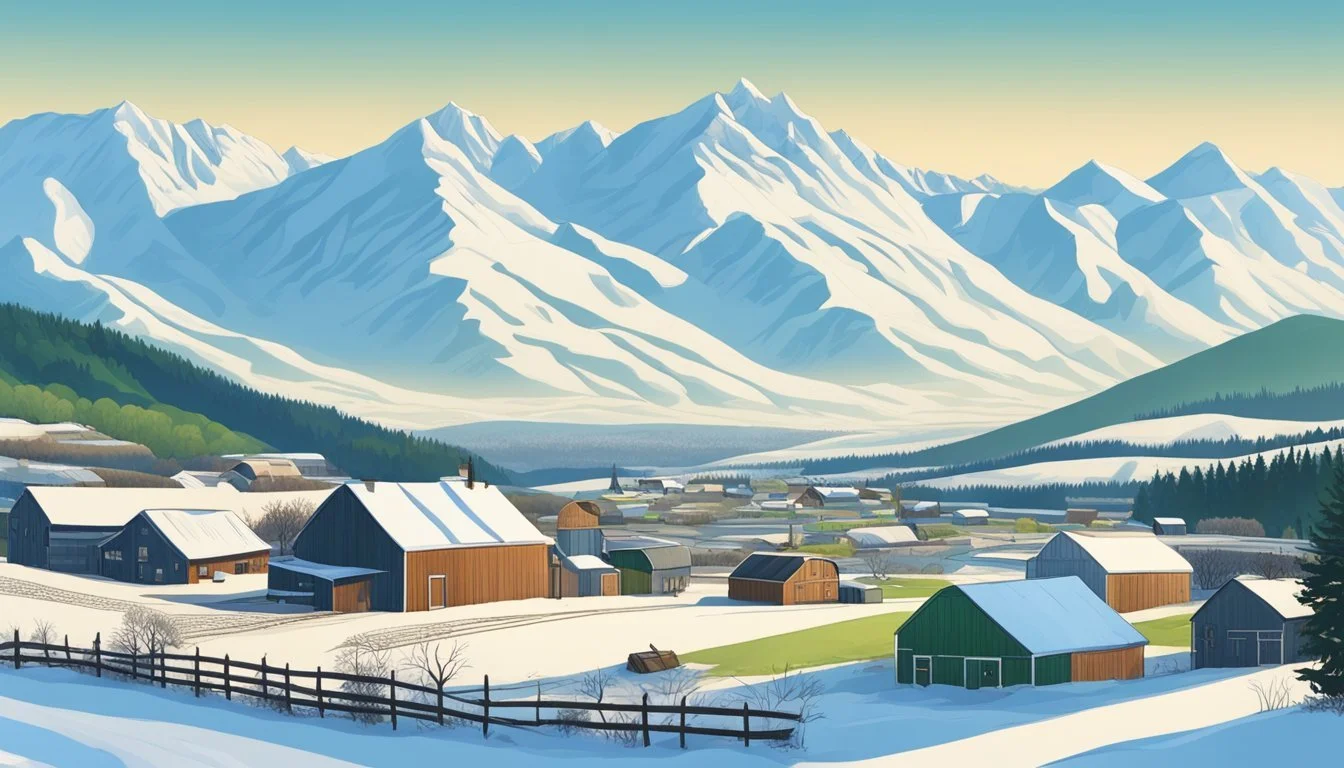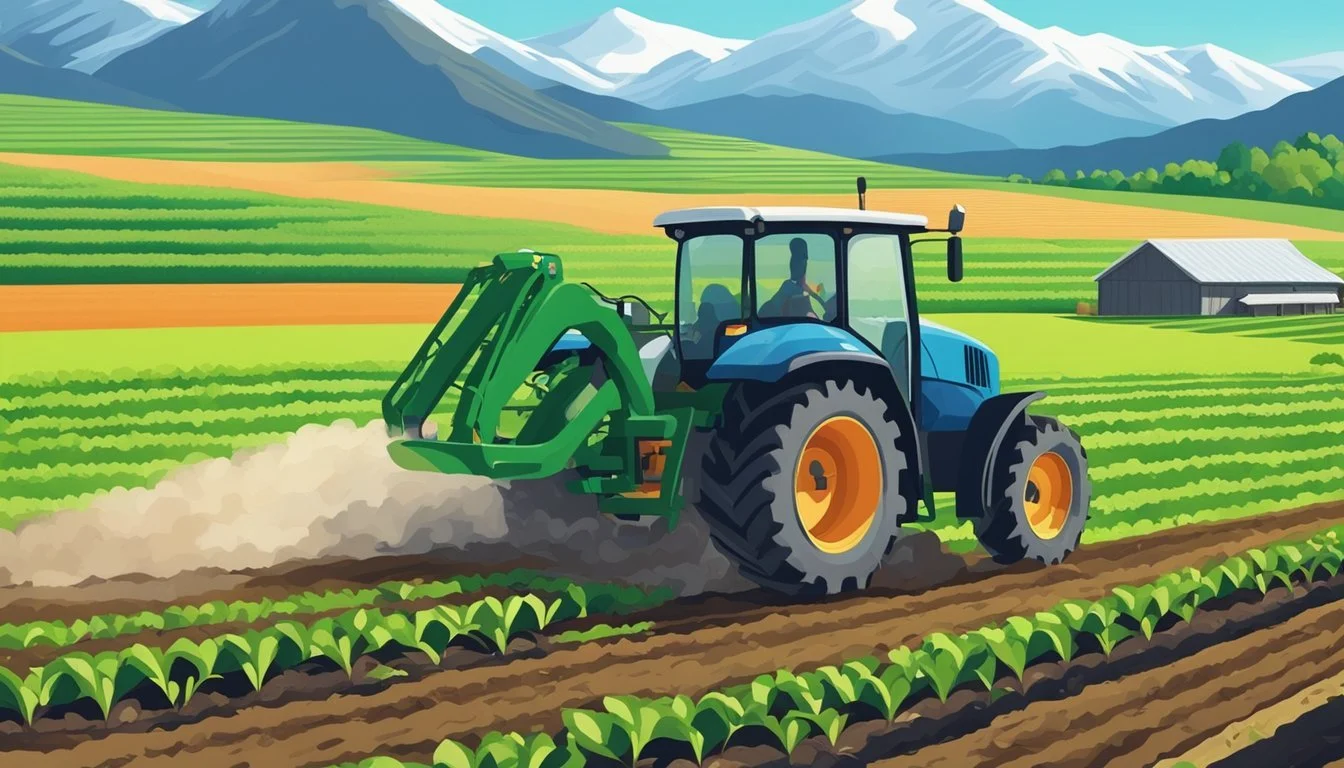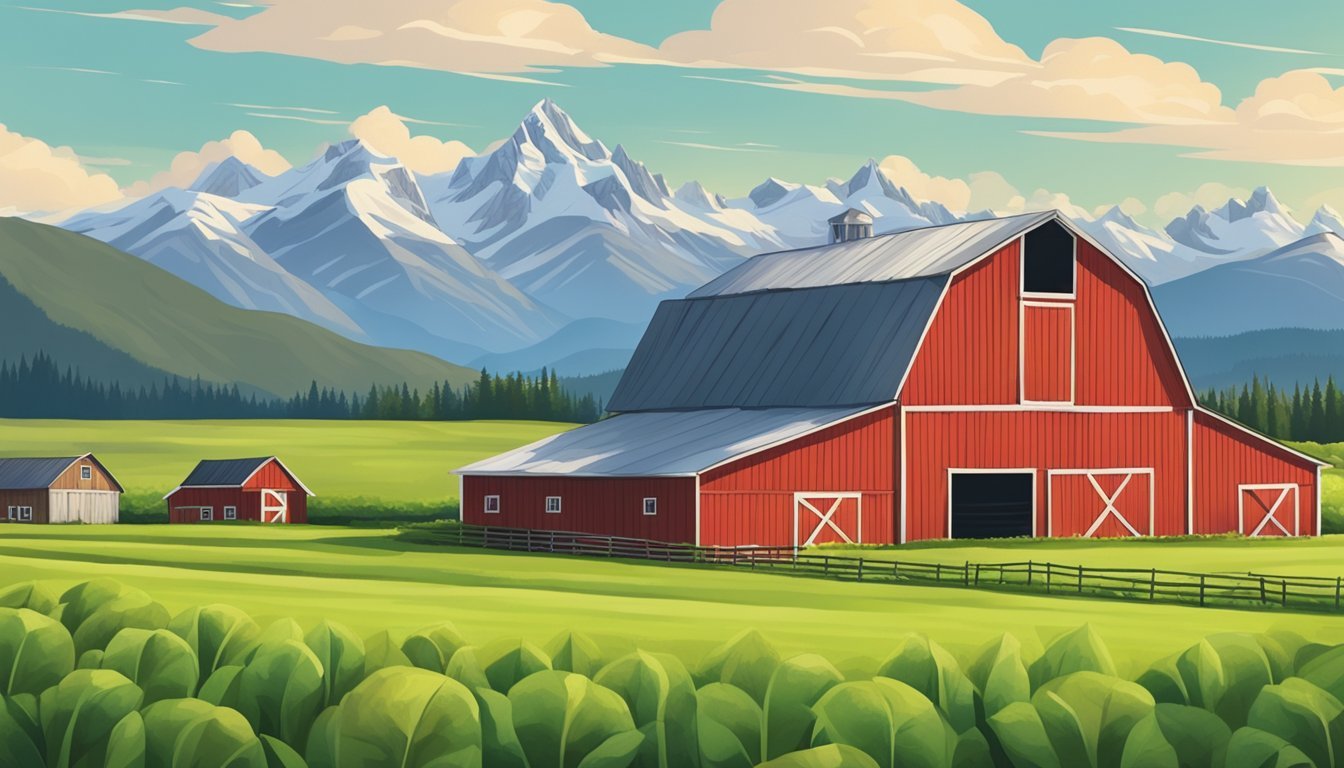Guide to Farming in Alaska
Essential Strategies for Success
This Article is Part of Our State by State Farming Guide
Farming in Alaska presents a unique set of challenges and opportunities due to its extreme climate and extended periods of daylight during the summer months. Despite the harsh conditions, the state has carved out a niche for agricultural success, contributing significantly to both local economies and the state's overall food security. With a net value of over $3 million annually, potato farming stands as one of the most valuable agricultural sectors in Alaska. The long hours of sunlight during the summer months prompt an interesting phenomenon where some crops, such as carrots, rutabagas, and cabbages, grow to record-breaking sizes, a testament to the state's agricultural potential.
The agricultural industry in Alaska is multifaceted, featuring an array of greenhouse and nursery crops, hay production, dairy, and a range of livestock including cattle, reindeer, bison (What wine goes well with bison?), and yak. While the seafood industry dominates, accounting for a significant portion of commercial seafood harvested in the U.S., local farms also produce barley, oats, and other cereals that contribute to the state's economy and food supply. Initiatives such as the Nenana-Totchaket Agricultural Project exemplify ongoing efforts to bolster food security through increased local production, ensuring that Alaska's agriculture continues to adapt and thrive even in challenging conditions.
These initiatives, paired with the natural advantages of extended daylight, enable Alaska to support a unique agricultural sector unlike any other in the United States. As such, farming in Alaska not only serves as a cornerstone of the local economy but also plays a crucial role in sustaining the communities that call this rugged landscape home.
Understanding Alaska's Unique Climate
Alaska's extreme latitude influences its climate, creating unique conditions for farming. The state experiences vast temperature ranges, prolonged daylight during summer, and rapidly changing climate patterns.
Climate Characteristics
In Alaska, the climate varies significantly from the southern coastal regions to the interior and northern areas. Coastal areas generally have milder temperatures and higher precipitation, while the interior experiences more extremes—with very cold winters and surprisingly warm summers. Temperature fluctuations can be extreme, with some areas witnessing a range from -60°F in the winter to over 80°F in the summer.
Impact of Long Summer Days
During the summer, Alaska benefits from long summer days due to its high latitude. Some regions enjoy up to 24 hours of daylight around the summer solstice. This phenomenon, known as the Midnight Sun, allows crops to photosynthesize for extended periods, which can lead to rapid plant growth during the brief but intense summer season.
Advantage: Extended photosynthesis can produce larger vegetables and support certain crops that require more sunlight.
Challenge: The constant daylight can also disrupt the normal growth cycles of some plants if not managed properly.
Effects of Climate Change
The impact of climate change on Alaska's agriculture is a double-edged sword. As the state warms at approximately twice the global average rate, the growing season has extended. This change has facilitated new agricultural opportunities in regions previously considered too harsh for traditional farming. However, these benefits are not without their drawbacks:
Positive: Longer growing seasons and milder temperatures.
Negative: Increased pest activity, unpredictable weather events, and potential negative effects on soil.
Aspect of Climate Change Impact on Alaska's Agriculture Extended Growing Seasons Positive: Allows for more varied crops and extended harvest times. Increased Pest Activity Negative: Requires more vigilance and new strategies for pest control. Unpredictable Weather Negative: Can lead to crop damage and challenges in planning.
The climate characteristics, the peculiar daylight patterns, and ongoing climate change all shape the agricultural landscape of Alaska, presenting both opportunities and challenges that require strategic adaptation by farmers.
Soil and Terrain Conditions for Agriculture
Alaska’s agricultural potential is framed by unique soil and terrain conditions that necessitate innovative cultivation approaches. Farmers in the region contend with a variety of soil types and terrain variations that challenge traditional farming practices.
Soil Types
Alaskin soils commonly range from loamy to sandy substrates, with many areas featuring acidic soil that can benefit from amendments such as lime or wood ash. In some areas, particularly the Matanuska Valley, farmers work with Knik soil series which are conducive to forage crop cultivation. The presence of silt and organic material can greatly influence soil fertility and, subsequently, the choice of crops that can be successfully grown.
Terrain Variations
The agriculture terrain in Alaska spans from flat lowlands to rolling hills. Location-specific terrain influences farming practices; for instance, the flat terrain of the Matanuska-Susitna Valley is well-suited for large-scale agriculture, while other areas with more varied topography may be better suited for specialized crops or pastureland. Farmers must constantly adapt to the terrain's impact on drainage, sunlight exposure, and soil depth.
Utilizing Greenhouses and High Tunnels
To compensate for shorter growing seasons and colder temperatures, Alaskan farmers increasingly rely on greenhouses and high tunnels. These structures protect crops from the harsh conditions and allow for an extension of the growing season. Greenhouses and high tunnels vary in complexity, from simple row covers to fully controlled environments, offering a range of options based on the farmer's needs and location-specific challenges.
Key Agricultural Practices in Alaska
Alaska's unique environment necessitates specialized agricultural practices to manage the brief growing season and diverse climatic conditions.
Planting Strategies
Farmers in Alaska optimize their planting strategies to accommodate the short growing season. Utilizing greenhouses is a common approach, allowing for an extended growing period and protection from the variable weather. Raised beds and tunnels also play a critical role in soil warming and microclimate creation, making it feasible to cultivate a variety of crops.
Seasonal Adaptations
Agricultural practitioners in Alaska must make seasonal adaptations to succeed. As daylight varies significantly throughout the year, light supplementation in greenhouses during the darker months is essential. Moreover, selecting crops with varied maturation times helps in harvesting different produce throughout the growing season, maximizing yield within the limited timeframe.
Crop Selection and Rotation
Picking the right crops is pivotal for Alaskan farmers. Crop selection often includes hardy vegetables like potatoes and cabbage, which can tolerate cooler temperatures. Crop rotation is practiced to maintain soil health and to manage pest and disease cycles. Barley and oats are among the grains that are successfully grown, offering valuable rotation options for maintaining agricultural sustainability in the region.
Main Crops and Livestock
Alaska's unique climate and day length variations create distinct challenges and opportunities in agriculture. Nonetheless, Alaskans successfully produce a variety of crops and maintain diverse livestock, contributing significantly to the state's food security and economy.
Vegetable Farming
Alaskan farmers cultivate a range of hardy vegetables capable of thriving in cooler climates. Potatoes are notably valuable, contributing millions to the state's economy. Other commonly grown vegetables include:
Carrots: Sweet and crisp due to the cool Alaskan climate.
Cabbages: They grow large and are a local staple.
Rutabagas: A root vegetable well-suited for colder temperatures.
Cereal Cultivation
The shorter Alaskan growing season necessitates the cultivation of cereals that can grow to maturity in a limited time. The key cereals include:
Oats: Adapted to cool weather, they serve both as a crop and livestock feed.
Barley: Grows relatively quickly and is versatile for both human consumption and animal fodder.
Hay: Though not a cereal, hay is a crucial crop, primarily used for feeding livestock throughout the year.
Livestock and Dairy Production
Livestock farming in Alaska is diverse, encompassing traditional and unique animals adapted to the environment. Key aspects include:
Dairy Production: Though less prominent than other sectors, dairy farms provide fresh milk within the state.
Cattle and Calves: Raised for both meat and milk, adapted breeds fare well in the Alaskan climate.
Bison and Yak: Offering alternative meats, these rugged animals are well-suited to the Alaskan terrain.
Reindeer: Not only a cultural icon but also a contributor to the livestock industry, reindeer are farmed for meat, wool, and antlers.
The Role of Research and Education
Research and education are crucial in equipping Alaskan farmers with the knowledge and tools they need to address the unique challenges of agriculture in the region.
University of Alaska Fairbanks
The University of Alaska Fairbanks (UAF) serves as a centerpiece for agricultural research, offering programs designed to promote sustainable farming practices and food security. The institution conducts critical research, particularly in the areas of crop science and animal husbandry, tailored to the Alaskan environment's specific needs.
Agricultural Experimentation
Through agricultural experimentation, scientists and researchers work to develop new techniques and processes that improve the viability of farming in Alaska's extreme conditions. This includes the development of cold-hardy crop varieties and livestock breeds suited for local climates. USDA grants often support such research, ensuring continuous innovation in sustainable agriculture.
Extension Services
Extension services in Alaska provide farmers with practical education and resources to enhance their operations. The services disseminate research findings and work closely with the community to implement best practices for the cultivation and conservation of local ecosystems. These services commonly involve:
Climate change adaptation strategies.
Tactics to boost farm resilience.
Outreach programs for water and land protection.
The information and guidance offered through these services are invaluable to the Alaskan agricultural community.
Alaska's Farming Economy
The agricultural sector in Alaska contributes significantly to the state's economy, with a focus on sustainable production and local food systems. Despite the challenges posed by the Alaskan climate, the farming industry remains an important force for food security and economic growth.
Market Analysis
Alaska’s farming industry, though not the largest in economic output, plays a crucial role in the state's economy. In recent years, there has been a rise in greenhouse and nursery crops, making them the fastest-growing segment in the sector. Potatoes represent one of the most valuable crops, adding over $3 million annually to the economy. The Nenana-Totchaket Agricultural Project illustrates the state's commitment to optimizing sustainable agriculture, thereby supporting both food security and economic stability.
Export and Trade
Trade and export within Alaska's farming sector may not be as prevalent as in other states, due to its geographic isolation and harsh weather conditions. However, the state takes initiative to promote local agricultural products through the "Alaska Grown" program, aimed to boost the visibility and marketability of Alaskan products. The emphasis remains on maintaining the health of local land and water resources while supporting the economy through locally-grown food and other agricultural commodities.
Local Food Systems
Food self-sufficiency is a significant aspect of Alaska's farming economy. With only 4 percent of farmland accessible and viable for farming, and less than 10 percent of food consumed being grown locally, the state has identified the preservation of farmland as a priority. Efforts to stimulate local food systems are linked closely with both the economy and food security. By bolstering local food systems, Alaska aims to reduce its reliance on imported food, therefore promoting both economic resilience and sustainability.
Wildlife and Environmental Stewardship
In Alaska, balancing the needs of agriculture with environmental stewardship involves the adoption of sustainable practices, careful wildlife management, and diligent tundra conservation.
Sustainable Practices
Farmers in Alaska embrace sustainable practices to reduce environmental impact and safeguard the ecosystem. They may participate in programs like the Conservation Stewardship Program (CSP), which encourages them to exceed minimum conservation standards. Through CSP, farmers can enhance their land's sustainability by addressing concerns such as soil health, water quality, and wildfire risks. Eligible large landowners, including Alaska Native Corporations, often work with Forest Stewardship Coordinators and Stewardship Foresters to create and maintain wildlife habitats while managing their agricultural activities.
Wildlife Management
Responsible wildlife management is essential for protecting the diverse species that inhabit Alaskan farmlands. Farming practices are tailored to minimize conflict with wildlife, preserving the natural habitat for animals like caribou, bears, and migratory birds. DNR Division of Forestry & Fire Protection plays a critical role in working with farmers to manage lands prone to wildfires, which can have a devastating effect on both wildlife and agricultural resources.
Tundra Conservation
The tundra ecosystem is a critical and sensitive component of Alaska's environment. Farmers and conservationists work together to protect this unique landscape from threats such as drought and human encroachment. Practices like the Agricultural Conservation Easement Program (ACEP) support the safeguarding of tundra areas by providing financial assistance for conservation easements, ensuring that these lands remain undisturbed and continue to support varied wildlife and plant species.
Seasonal Events and Community
In Alaska, seasonal events and community involvement are pivotal to the agricultural landscape, fostering a resilient economy and celebrating the unique farming conditions of the state.
Alaska State Fair
The Alaska State Fair is a crucial annual event marking the end of the growing season. It is held in Palmer, the heart of the Matanuska Valley, showcasing Alaska's largest vegetables and agricultural achievements. The fair not only highlights the bounties of local farms but also boosts the local economy by attracting tourists and fostering community pride.
Farming Communities
Farming communities in Alaska often stem from historical projects like the Matanuska Colony, which brought families to develop self-sufficient farms. Over time, these communities have evolved, with today's farmers in areas like the Mat-Su Valley supporting each other through shared knowledge and resources. They are the backbone of Alaskan agriculture, contributing significantly to both community well-being and the state's economy.
Agricultural Tourism
Agricultural tourism is growing, with visitors keen to experience the unique farming methods and produce of Alaska. Community Supported Agriculture (CSA) programs are popular among both locals and tourists, as they offer fresh seasonal produce and an interactive insight into Alaskan farming. This interaction not only educates but also injects vital funds into the agricultural sector, supporting local farms and the wider economy.
Future of Farming in Alaska
The future of farming in Alaska is being shaped by the convergence of climate change and technological innovation, with increasing government support bolstering the state's agriculture sector. Adaptations to new challenges pave the way for a more robust food system, leveraging the state's unique growing conditions.
Technological Advancements
High tunnels and greenhouse technologies are revolutionizing the way Alaskans approach farming. By creating controlled environments, farmers can extend the growing season for nursery and specialty crops, mitigating the risks associated with the harsh climate. Advances in precision agriculture allow for more efficient use of resources, applying water and nutrients directly to plant roots with minimal waste.
Hydroponics and aeroponics systems are gaining traction for their water efficiency and high yield in small areas.
Drones and satellite imagery are being utilized to monitor crop health and soil moisture levels, aiding in early detection of pests or disease.
Policy and Support
Recent policy measures aim to support local farmers and enhance food security in Alaska. Grants and technical assistance are provided by entities such as the U.S. Department of Agriculture (USDA) to empower local communities and Alaskan Natives to grow their own food.
USDA 2501 grants: Support for underrepresented farmers, connecting them to resources.
Agriculture Infrastructure: Investment in infrastructure to encourage local food production.
This level of support indicates a strong commitment from policymakers to strengthen Alaska's agricultural capabilities and foster sustainability.
Adapting to New Challenges
Alaskan farmers are increasingly adopting practices to adapt to climate change, which presents both opportunities and challenges. The warming climate has led to some regions being able to support crops previously unsuitable for the state's colder temperatures.
Crop Rotation: Essential for soil health and pest management.
Soil Enhancement: Organic amendments improve resilience against variable weather patterns.
By adapting to these new conditions, Alaskan farming is positioned to experience growth in both the production of traditional crops and the introduction of new varieties, making strides in self-sufficiency and sustainability.
Resources and Further Reading
For those interested in the intricacies of farming in Alaska, a range of resources is available.
Government and Educational Resources:
Natural Resources Conservation Service: Visitors can access information on farming practices in Alaska's unique conditions.
Division of Agriculture - Alaska: This division aims to promote the agriculture industry, providing updates on agricultural land sales and resources.
Non-Profit Organizations:
Alaska Farm Bureau: Through "Alaska Agriculture in the Classroom," they educate students about the origin of their food.
Alaska Farmland Trust: Offers community outreach and works toward the preservation of farm lands in Alaska.
Practical Guides:
Alaska Farmers Market Association: Offers a range of field guides, including:
Hoophouse Internals
Soil Blocking for Transplants
Drip Irrigation Basics
Educational Blogs:
National Geographic Education Blog: Provides insights on Alaska's growing season and how technology and climate are changing farming practices.
To delve deeper into these topics, readers are encouraged to visit the organizations' official websites or contact them directly for the most current and detailed information. As farming in Alaska continues to adapt and grow, so will the resources available to those interested in this field.










